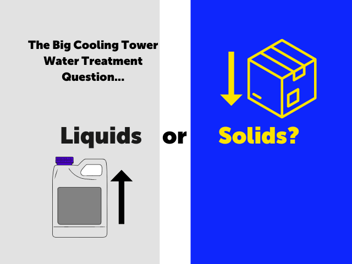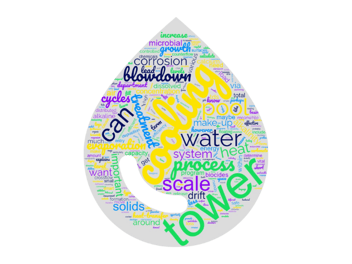Environmental Aspects of Cooling Tower Controlled-Release Chemistry
Smart Release Technology
The importance of green chemistry to reduce environmental impact has been growing year by year. Because of this trend, many companies, communities, and local or state governments now have “Green” or “Sustainability” targets that they are required or strongly urged to meet.
To address this growing demand, many AWT companies are evaluating the need to integrate new technologies into their portfolio that focus on safer, lower carbon foot print water treatment solutions. Controlled Release Technologies provides AWT companies an option to offer their customer base to help them reduce carbon footprint, hazardous liquid chemical inventory, and energy usage. The focal point of this abstract will be to offer an approach for Green comparison based on carbon footprint and other environmental and safety factors. As shown, the predominant objective of any cooling treatment program is maintaining clean heat exchange transfer surfaces and water conservation. This abstract demonstrates the favorable environmental impact of Controlled Release Technology in comparison to traditional liquid cooling water treatment solutions.
Carbon Footprint Calculation:
A very commonly used term associated with “Green” is “Carbon Footprint”. Carbon footprint is defined by the amount of carbon dioxide generated in the manufacturing, use, and disposal of a product. Some of the factors influencing carbon footprint are electrical energy consumption, natural gas consumption, product packaging materials, on site service frequency (fuel to travel to and from service visits), and fuel consumed to deliver products.
Application (Pumping) of Product in Cooling System:
There is negligible carbon contribution from the application of the product. Little to no detectable electrical or fuel requirements are needed to apply, pump, or transfer the controlled release technology product. Water is simply circulated through the feed equipment to slowly apply the chemical into the system. This water can be supplied from the water treatment controls flow piping thus eliminating the need for additional piping, water flow (pumping energy), and pressure losses. The carbon dioxide contribution is 0 lbs per year.
Total Controlled Release Technology Carbon Dioxide Contribution:
The total carbon dioxide contribution due to manufacturing, shipping, handling, and applying 400 lbs. of controlled release product and shipping it 500 miles to a destination is 208.9 lbs. of CO2. This does not factor in the energy and fuel required to obtain and manufacture the raw materials for the chemicals. This information was not readily available and for the purpose of the report is not required as both liquid and solid chemicals use the same amount of active ingredients.
Carbon Footprint Calculation for Traditional Liquid Products:
Disclaimer: For the intent of this calculation, an assumption must be made that the raw materials used for controlled release technology solid products are the same amount and type of raw material products used to make the equivalent liquid product. The obtaining and manufacturing carbon dioxide contribution figures for the raw materials were not readily available to include in this document. Since the factors should be moderately similar (liquid raw materials have a slightly higher carbon footprint due to shipping raw material weights and packaging in plastic), this will not be considered in the calculation. Additionally, this calculation will not include one time carbon dioxide contribution for application equipment such as feeders, chemical pumps, or chemical tanks (for either liquid or solid products). This exercise is for ongoing carbon dioxide footprint calculations only.
The process of making an equivalent traditional liquid product is as follows: adjust the temperature of the liquid to the design mixing temperature (some facilities do not perform this step while others do), add ingredients one at a time while mixing and not adding additional ingredients until each one is properly dissolved, once blended continue mixing for an additional hour. The comprehensive process to blend approximately 2000 lbs. of product takes approximately 2 hours depending on the facility, manufacturer, and equipment available. The following calculations show the specific carbon footprint calculations involved in producing and applying liquid chemical treatment.
Total Carbon Dioxide Contribution - Liquid Products:
The total carbon dioxide contribution due to manufacturing, shipping, handling, and applying 2000 lbs. of the equivalent liquid chemistry product and shipping it 500 miles to a destination is 792.98 lbs. of CO2. This does not factor in the energy and fuel required to obtain and manufacture the raw materials for the chemicals. This information was not readily available and for the purpose of the report is not required as both liquid and solid chemicals use the same amount of active ingredients.
Abstract Conclusion:
The information provided in this document is meant to elevate awareness and stress the importance of understanding Green principles and how to calculate carbon footprint. Controlled Release Technology is one option to offer end users interested in reducing carbon footprint and improving safety relative to traditional liquid chemical delivery methods. As defined by the US EPA, reducing toxicity and lowering impacts to the environment is one way to define Green. Controlled Release Technology accomplishes this and is one choice for companies to consider. Many factors and calculations go into determining carbon footprint. Generally, Controlled Release Technology will lower carbon footprint when compared to many other treatment strategies with the specific figures requiring to be calculated on a case-by-case basis.



